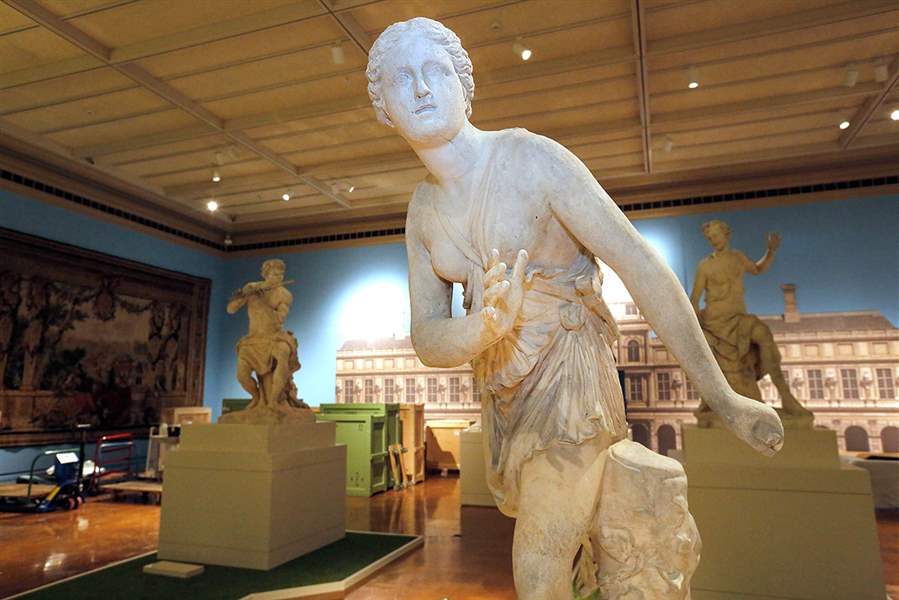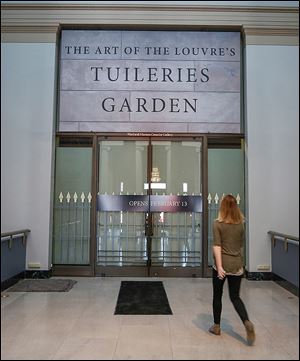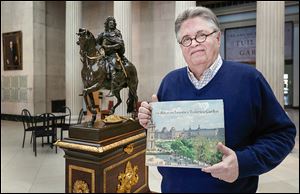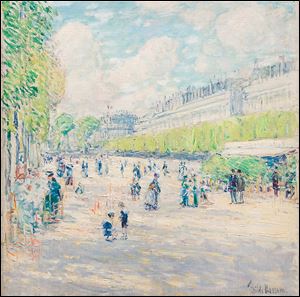
Exhibit brings piece of Paris to Toledo
Louvre’s Tuileries Garden blooms at Museum of Art
2/9/2014
From left to right: ‘Faun,’ by Antoine Coysevox; ‘Atalanta,’ by Pierre Lepautre; and ‘Hamadryad,’ by Coysevox. The sculptures are part of the more than 100 pieces of art in the Art of the Louvre’s Tuileries Garden exhibit at the Toledo Museum of Art. The exhibit will run from Thursday to May 11.
THE BLADE/JETTA FRASER
Buy This Image

From left to right: ‘Faun,’ by Antoine Coysevox; ‘Atalanta,’ by Pierre Lepautre; and ‘Hamadryad,’ by Coysevox. The sculptures are part of the more than 100 pieces of art in the Art of the Louvre’s Tuileries Garden exhibit at the Toledo Museum of Art. The exhibit will run from Thursday to May 11.
The garden in Paris that surrounds the Louvre has been the stage for exceptional works of art and inspirational urban green space for artists and pedestrians for more than four centuries. That European garden will come to life over the next three months at the Toledo Museum of Art.
The Toledo museum is one of only three museums in the United States — and the only in the Midwest — to host the major exhibit Art of the Louvre’s Tuileries Garden, which will include more than 100 sculptures, paintings, and photos from collections in France that had never traveled to the United States.
TOLEDO MAGAZINE: Garden of delights
PHOTO GALLERY: Click here to view photos of the exhibit

Lisa Reyerse looks at the door leading into the Tuileries exhibit. The exhibit is a collaborative effort by museums in Toledo, Atlanta, and Portland, Ore., and Paris.
The exhibition was a collaboration by directors and curators from the Louvre and from Toledo, the High Museum of Art in Atlanta, and the Portland Art Museum.
“A history of cultural expression through landscape is part of the legacy of France,” said Brian Kennedy, director of the Toledo Museum of Art. “It was created as a space for people, so if we want to learn lessons for our own city on creating space for people, we could look at the Tuileries Garden.”
The Tuileries (pronounced twee-luh-ree) exhibit, which opens Thursday and runs through May 11 in the Canaday Gallery, is part of a bigger plan by the museum to engage visitors in the history, splendor, and beauty of landscape architecture.
“We liked the idea of an exhibit being here as people think about their gardens and planting,” Mr. Kennedy said.
The garden holds a significant place in France’s social and political history through its role as an outdoor museum and as the subject for artists through the 16th century to present day.

Dick Putney, exhibit curator and art history professor at UT, holds ‘The Art of the Tuileries Garden,’ for which he contributed an essay. He says artists have been drawn to the space for centuries.
The history
It is said that one should not make major financial decisions when in mourning. In 1564, Catherine de Médici did the opposite.
Grieving the loss of her husband, King Henry II, who was killed during a tournament, the queen commissioned a grand palace and surrounding garden. Built on terrain that had been occupied by tile workshops, the garden earned the name tuileries, which means kilns.
Through the chosen pieces of art for the traveling exhibition, visitors will see the many layers of history the garden in Paris unpeeled, from the Renaissance period to the time of unrest during the French Revolution. French kings and other royal monarchs walked the garden, using it as a place of meditation, to host elaborate parties, and for strolls.
The exhibit marks the 400-year anniversary of the birth of landscape architect Andre Le Notre, the principal gardener for King Louis XIV. The king, in 1661, asked Le Notre to redesign the Tuileries into a formal French garden.
Le Notre had a keen eye for optical effects and an architectural mind immersed in artistic genius.
“In effect, he painted a garden into being,” Mr. Kennedy said.
Le Notre extended the main axis of the garden westward, creating the avenue that would become the Champs-Élysées. The garden lie between the building’s Louvre and Place de la Concorde on the River Seine.
The garden became the city’s first public park in 1667. The royal palace and its grounds, which closed off the western end of the Louvre, were burned down in 1871. The original palace was torn down in 1883.
Each year, 10 million people visit the 63 acres of garden, recognized as a public pedestrian-only space, essentially “their Central Park,” Mr. Kennedy said.

Childe Hassam, an American impressionist, depicted the Tuileries Garden in the late 1890s. The garden became Paris’ first public park in 1667. The orginal royal palace was torn down in 1883.
Coming to Toledo
The exhibit is part of a strategic plan the museum put together in 2010 to bring an international exhibit to Toledo each year; the last big exhibit was “Manet: Portraying Life,” a focus on Edouard Manet’s portraits that opened in October, 2012, and ran for more than two months.
In March, 2012, directors from the three museums met with personnel from the Louvre, including former Director Henri Loyrette, who is credited with maintaining and sustaining the garden in Paris since 2005. Together, they collaborated on organizing and bringing an exhibition to the United States that would encapsulate the garden and its vision. And tell the story.
The exhibition was displayed first in Atlanta from Nov. 3 through Jan. 19. Between the closing date and now, pieces in the collection have been uninstalled, packed away, and placed in trucks to be transported from Georgia to northwest Ohio.
Kristen Delaney, director of marketing and museum advancement at the High Museum, said the Atlanta museum does not track attendance but said that the show there was a success. She said transporting the pieces from Paris to Georgia was a challenge.
“A few of the sculptures in the Tuileries exhibition are very tall; so tall in fact that they had to be placed horizontally in their crates to be able to fit into the plane’s cargo hold for their trip to the High,” she said.
She said the High does not release information related to cost of transportation for exhibition objects.
The first delivery arrived in Toledo at the end of January.
When the exhibit closes here in May, the collection will travel to Portland, Ore., for display in its museum from June 14 to Sept. 28.
The three museums are sharing the expenses, including the shipping of the pieces, said Kelly Fritz Garrow, director of communications at the Toledo museum. They are working closely with art experts at the Louvre, who approved the catalog of pieces, compiled a video of the garden shown at the exhibit, and put together the checklist of artwork.
Drawing a crowd
Organizers expect between 30,000 and 50,000 people to visit the Louvre exhibit here. It is sponsored by The Andersons, Brooks Insurance, and Taylor Cadillac, and is supported by a grant from the National Endowment of the Arts through the Ohio Arts and by members of the museum.
“It’s really a coup to be able to work with the Louvre and have them send art that has never been outside Paris,” Ms. Fritz Garrow said, adding that the same classic lines and symmetry in the architecture of Le Notre is reflected in the Toledo museum, making the city a great fit for the exhibition.
“It’s not really about a star work of art. It’s about the experience of Paris and being in the garden of the Louvre,” she said.
The exhibition is also part of a bigger plan to capitalize on the art of green space and landscape.
To that end, the museum is organizing a major on-site sculpture exhibition in the summer of 2015, Mr. Kennedy said. Details of the outdoor exhibit, which is being curated by Amy Gillman, the museum’s associate director, are not yet being released, but it will speak to the continuation of a urban space and expand the Welles Sculpture Garden that hugs Monroe Street outside the museum, Mr. Kennedy said.
The Art of the Louvre’s Tuileries Garden.
■ Runs: Thursday through May 11.
■ Admission: $8.50 for adults; $5.50 for for students and seniors 65 and older. Free admission for members.
■ Information: 419-255-8000 and toledomuseum.org.
What you will see
Many of the garden sculptures in the Tuileries tell mythical tales, such as that of the goddess Pomona and her lover, Vertumnus, which was sculpted by artist Francois Barois in the 17th century.
When visitors pass through the gallery doors, they will enter a visualization of the garden by museum curators and designers. Walking through a transformed version of the garden and the Louvre will give visitors a sense of the accomplishments of French artists, as well as a feel for what the garden are like without stepping foot in Paris, said Dick Putney, the exhibit's curator and an art history professor at the University of Toledo.
“It’s an inspirational space that has drawn artists to it for centuries,” he said, adding that Impressionists would spend days in rented rooms or apartments, painting the garden below.
It’s a history lesson and also a re-creation of what visitors to modern-day Paris enjoy now.
“I think what I like most is the effort we have made to conceptualize a garden with magnificent sculpture and its relationship to the great building that is now the last Tuileries Palace,” Mr. Kennedy said. “We want people to see not just historic circumstance, but a living, breathing space.”
Through the chosen collections of art, visitors will see the many layers of history the garden in Paris hold. The museum will conduct talks and demonstrations throughout the exhibit’s time here, including a free presentation on Le Notre on March 13 and a collaboration between florists and glassblowers to create arrangements and their vessels to coincide with Mother’s Day.
The oldest pieces in the exhibit are from the 1560s and were remains of the original Tuileries Palace that were uncovered during excavations after the French Revolution.
The most recent piece in the exhibit is a 1985 photograph.
The works of notable artist include nine large sculptures created by François-Joseph Bosio, Antoine Coysevox, and Aristide Maillol that once stood in the garden and are now displayed inside the Louvre for protection.
Weathered from their years outdoors, the sculptures — some 11 feet tall — are “pretty spectacular — quite large and impressive,” Mr. Putney said.
The exhibit also includes paintings, photos, and drawings that depict the Tuileries, including works by renowned painters Édouard Manet, Camille Pissarro, and Childe Hassam, and photographers such as Eugène Atget, Henri Cartier-Bresson, and André Kertész.
“It’s a wonderful photography show, it’s a wonderful painting show, and it’s a wonderful sculpture show,” Mr. Putney said. “The subject though, is the garden and its art over many centuries.”
Contact Roberta Gedert at: rgedert@theblade.com or 419-724-6081.